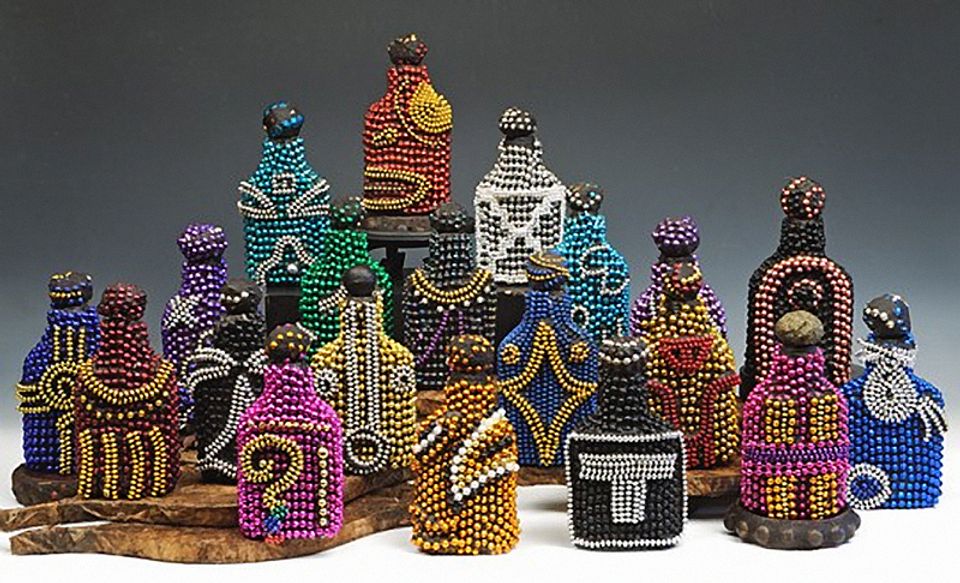
Join us this Saturday, June 25 at 1:30 p.m. for the latest installment of our Luce Artist Talks series. This month's talk features mixed-media artist Anne Bouie, who strives to "express the universal themes of order, harmony, growth, beauty, and transcendence" in her work. Bouie's pieces are inspired by the traditions of indigenous cultures and southern American folk artists and she will talk about the artworks in the Luce Foundation Center that inspire. The Luce Artist Talks series is presented in collaboration with CulturalDC's Flashpoint Gallery.
Eye Level: You studied history and education in school, but not art. Was this a conscious decision on your part?
Anne Bouie: One of my professors at UC Riverside suggested I apply for STEP (Secondary Teacher Education Program) at Stanford. Once there, I explored getting a degree in Administration and Policy Analysis; doing so required a graduate degree outside the School of Education. I chose history because, as William Faulkner said, "the past is never dead. It's not even past." The traditional interpretation of the African-American experience, particularly the antebellum period, has not served anyone in America very well, but especially Black people. Consciously addressing the impact of the interpretation and presentation of history was my approach when teaching, and is a primary theme that guides my work as an artist. Connected to this is my use of history and education to explore the cultures and beliefs of indigenous peoples prior to the advent of modern, organized religion.
I have observed there are universal and timeless spiritual principles found among peoples across time and space, such as regard for the Earth and all sentient beings, ancestors, elders, children, and the notion of realms and beings beyond those that the five senses can access.
EL: When did you know you wanted to be an artist?
AB: There wasn't a moment when I knew I wanted to make art. I have always foraged and collected components used in work simply because they were interesting or beautiful. My involvement was a response to an invitation from Aziza Gibson-Hunter to participate in the show, Found hosted by The Graham Collection in 2006.
The transition from "urban educator" to "full-time" artist has been gradual —after a person has invested so much time and effort in one area, it feels inappropriate to just walk away from it. However, as my art has manifested over the years, it has required ongoing historical research and study.
EL: How has living and working in Washington, D.C. affected your work?
AB: Being in Washington has afforded access to the eastern terrain, geography and botanicals not found elsewhere. The history found in the District, particularly in the African American community, is also a treasure.
EL: Can you describe your artistic process for us? Do you have any particular rituals when you are working?
AB: I experience art as a spiritual process, and one that I do not do alone. Meditation and prayer are integral aspects of my process. I feel most connected when I am making art. I allow guidance in, I take risks, I listen, and feel open to the present. I have often been given ideas and techniques I did not consciously sit down and "figure out." Sometimes, I can see a finished piece, and it is as if it almost composes itself —as long as I do not get in the way. I keep a sketchbook so I can put ideas down as they come to me. My work involves a lot of "moving parts," so foraging and gatherings are a large part of my process. I am very busy in the fall, because everything ripens then.
I organize and sort what I've collected so I am able to access things easily. I may not know when or how I will use a particular object, but if it is interesting and compelling, I gather it and wait for its time and place. I like to work in series so I can explore different iterations on a particular theme or idea. Sometimes things don't work and I am forced to try until the "aha" of the fit shows up.
EL: How do you hope other people respond to your artwork?
AB: I aspire to make work that resonates at the aesthetic, functional, and experiential levels. I want to make work that has "soul and sense" where it touches and connects with the soul and spirit. I also want it to say something to the mind and the intellect. The stories and messages of my work may evolve over time, and can continue to reveal or illuminate new perspectives, energy and information for the viewer. Each piece resonates differently to the viewer.
Bouie's current installation, The Four Movements of the Sun, is on view at Flashpoint Gallery until July 9. After her talk in the Luce Center, attendees may visit the gallery with Bouie to continue the conversation there.


















